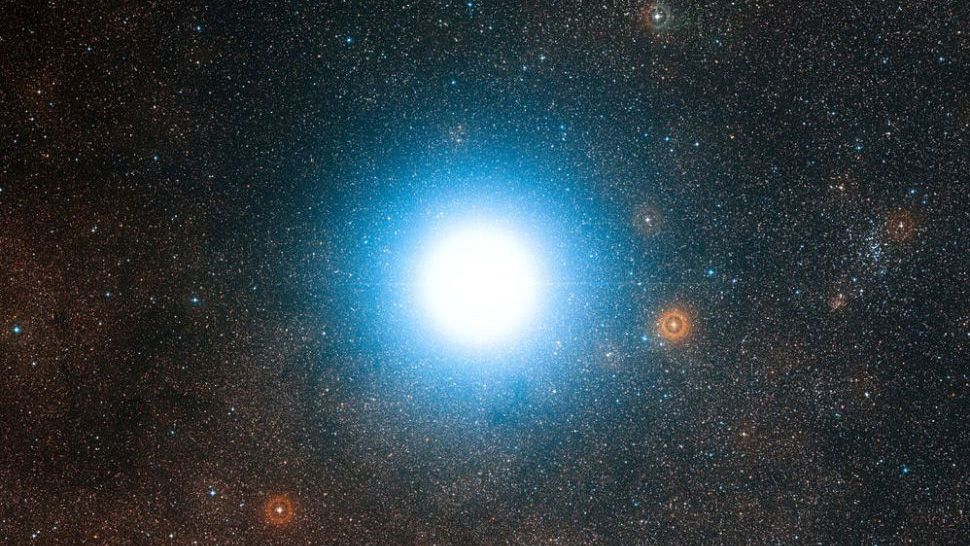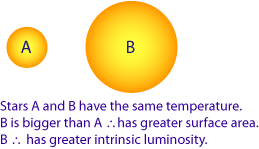The Lumnosity of This Starcan Be Best Described as
A Star Bs radius is about 640000 times larger than star As radius. What do neonoxygen and nitrogen have in common.

Brightest Stars Luminosity And Magnitude Explained Space
Low luminosity Low temperature stars b.

. Most nearby stars fall into which luminosity class. Approximately the same luminosity as a white dwarf. It determines how bright a star appears to be.
10M 5M 1M 05M. A stars luminosity depends on the stars temperature and size and both of those things are determined by the stars mass. B Star Bs radius is about 800 times larger than star As radius.
Arcturus star is the brightest star in the constellation Bootes and fourth brightest star in he night sky. The most common stars are best described on the HR diagram as. The one that has the lowest luminosity or furthest away or both.
Directions 36 - 50. On a standard HR diagram where would you find the most massive main sequence stars. Which of the following protostars will reach the main sequence the fastest.
Which of the following statements best describes the mass in the outer parts of the Milky Way beyond the orbit of the sun. A stars luminosity is the. What correctly describes the relationship between the luminosity of two stars that have the same radius.
A star can only be accurately classified once data on its absolute magnitude is acquired. Aless than the luminosity of the Sun Bgreater than the luminosity of most stars in the main sequence Capproximately the same luminosity as a white dwarf Dapproximately the same luminosity as Aldebaran 36The luminosity of this star can best be described as Acontact metamorphism Binternal crystallization Cnuclear fusion Dradioactive decay. E total amount of light that the star radiates each second.
If a question is unclear ask for clarification during the exam. Its unit is Wattmeter2. C lifetime of the star.
What would we expect the number of chromosomes in a normal cell to be. Greater than the luminosity of most stars in the main sequence. 8 solar mass stars have 1000 L and last about 80 million years.
Earth Sciences questions and answers. Read each problem carefully and read through all the answers. L 2 4 2 x 2 x 2 x 2 16 times the suns luminosity.
Decreasing luminosity at constant temperature then increasing temperature at constant luminosity. 4 A stars temperature can be determined by measuring the spectrum color of the star. The luminosity of this star can best be described as Less than the luminosity of the sun As altitude increases in the troposphere and stratosphere the air temperature.
The HR Diagram categorizes stars by surface temperature and. 4 solar mass stars have 100 L and last about 400 million years. Small low temperature Choose.
Luminosity is denoted by L. The evolution of a solar mass star on the H-R diagram can best be described as. Answer all questions in this part.
The luminosity of this star can best be described as. Less than the luminosity of the Sun. The luminosity of this star can best be described as.
For each statement or question choose the word or expression that of those given best completes the statement or answers the question. The luminosity of this star is 170 times the solar luminosity. Some questions may require the use of the 2011 Edition Reference Tables for Physical SettingEarth Science.
Choose the answer that best completes the question. Two red stars have surface temperatures of 3000 K but Star As luminosity is about 5 of the Suns and Star Bs luminosity is about 32000 times the luminosity of the Sun. A apparent brightness of the star in our sky.
D total amount of light that the star will radiate over its entire lifetime. Red Dwarf Red Supergiants Main Sequence Blue Supergiant All of the nearby stars are part of what luminosity class. Low luminosity High temperature stars.
Keep your copy of. Part B - 1. 43 The luminosity of this star can best be described as 1 less than the luminosity of the Sun 2 greater than the luminosity of most stars in the main sequence 3 approximately the same luminosity as a white dwarf 4 approximately the same luminosity as Aldebaran.
The luminosity of a star can be determined by measuring the _____ in the stellar spectra. Luminosity 0001 Cosmic Microwave Background Radiation In the 1920s Edwin Hubbles discovery of a pattern in the red shift of light from galaxies moving away from Earth led to the theory of an expanding universe. 1 solar mass has 1 solar luminosity L and lasts about 10 billion years.
Luminosity of Star R 2 x T 4. 6 Luminosity is a measure of a stars power output energy per second. The total amount of energy emitted per second in Watts.
Mark your answers on the scantron sheet and on your copy of the exam. The more massive the protostar the faster it evoles. So L SUN 385 x 1026 Js or watts.
Aless than the luminosity of the Sun Bgreater than the luminosity of most stars in the main sequence Capproximately the same luminosity as a white dwarf Dapproximately the same luminosity as Aldebaran 36The luminosity of this star can best be described as Acontact metamorphism Binternal crystallization Cnuclear fusion Dradioactive decay. How it appears from Earth how bright it would appear from a standard distance and how much energy it emits. Approximately the same luminosity as Aldebaran.
High luminosity Low mass stars c. A particular star can appear. The brightness of a star is measured several ways.
2 solar mass stars have 10 L and last about 2 billion years. The power per meter squared as measured at a distance from the star. How much bigger is star B than star A.
Select the luminosity class that is best described by each question. What is the Suns luminosity class. B surface temperature of the star.
What Factor Affects The Luminosity Of A Star Quora

Comments
Post a Comment